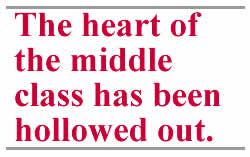
To Morris and her co-authors, declining wage growth is more than a leading economic indicator. It's a threat to the promise that made America the land of opportunity—work hard and you'll get ahead.
"The purpose of this book is to push researchers and policy makers toward a sustained focus on how the life chances of American workers have changed," they write. "Upward mobility—the hallmark of this country—hangs in the balance."
In coming to her conclusion, Morris found some solid gold data—two National Longitudinal Surveys from the federal Bureau of Labor Statistics. What makes them unique is that they're longitudinal. Instead of examining a different cross-section every year, each survey follows the same group of 2,500 young men from their teens into their mid- to late 30s.
It's that distinction which allows the authors to track and compare long-term wage gains—the heart of upward mobility. "Nobody's used them the way we did, which was comparing the two cohorts in their economic mobility over the full 16-year period," says Morris.

Flawed data from the first survey is the reason Divergent Paths explores only the plight of white males, she adds. Because women worked outside the home less often in the late 1960s, they weren't consistently asked the same set of questions as men. In addition, more than half of the non-white males included in the original survey dropped out over the 16 years, preventing meaningful statistical comparisons.
"We know from other studies that women and minorities made some gains during this period, but inequality also grew within these groups, much as it did with white men," says Morris. "This growth in inequality appears to be the signature of the new economy."
Shelly Lundberg, an economics professor at the UW, says it's no surprise that Divergent Paths documented a growing gap between the top and bottom rungs of the ladder. "Inequality in earnings has been the key statistic in labor economics for the last 15 years, " she says. Nevertheless, the book offers "corroborating evidence supporting what we always knew," says Lundberg. "And it's pretty concrete in the way it compares the two cohorts. It's a very eloquent book."
One of the grimmest trends the authors probed was the growing gap between high and low achievers. The chasm widened 20 percent—not because those at the top did so much better, but because those at the bottom did so much worse. Not only that, but the number of people mired in low-wage jobs more than doubled—from 12 percent in the first cohort to 28 in the second.
"We went into the study with a sense of what we'd find, but we didn't know so many people were getting stuck in the lower-end jobs and are cycling through them until their mid-30s, unable to rise to a position where they would have a family wage job," says Morris.
At the same time, the payoff for most college degrees declined. Only college graduates in the small finance, insurance and real estate sector consistently posted higher wage gains than their predecessors. "The people who chase the money have the money," says Morris. "I guess that's not so surprising.
"It was a surprise to me that education wasn't a big boost," adds Morris, "especially among those that went to college but didn't get a four-year degree, which is about 25 percent of the population. We found they lost ground just like the high school graduates."
Jack Faris, the UW's vice president for university relations and a former sociology professor, says the key point is not the diminished earning power from a college degree, but the heightened consequences of not having one. "A four-year college degree is even more critical than ever before," says Faris. "The difference is that instead of being an automatic passport into the upper middle class, it's more of an absolute necessity for penetrating the lower middle class."